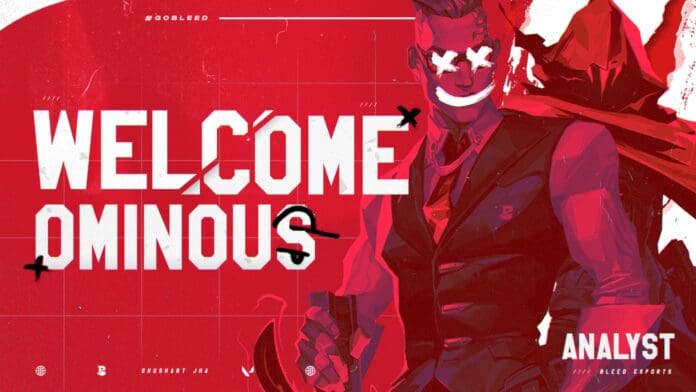Bleed is among the strongest teams in the Malaysia/Singapore Valorant circuit amongst teams like Paper Rex. Bleed has solidified its position as a strong contender for this split’s APAC representation for Valorant Champions Tour Masters Copenhagen, Especially after their solid Play-In stage run.
Coming Thursday, Bleed is set to face the top seed from Philipines, Team Secret. The key factor in a team’s performance is the Coach and the Support Staff, and we were fortunate enough to interview Bleed’s Analyst Sushant Jha aka Bleed Ominous.
Ominous is a 22-year-old Computer Science graduate who decided to use his technical skills for esports and has been working in esports since September 2021. The Young Analyst was always interested in playing Tactical FPSs, starting with CS Source back in the day and then CSGO for six years, transitioning to Valorant when the Beta came out.
He used the nickname Ominous because he enjoyed playing with the alias. And despite playing tact-FPS for eight or so years, Ominous was always interested in getting on the management side of things instead of playing.
Being a computer science engineer, Ominous was introduced to Data Visualization and Machine Learning and being a football fan. He started applying the data visualization techniques he learned in football matches; he posted them on Twitter.
But with football being a traditional sport and many people already doing it, He chose to switch to his other passion, Valorant.
He then started posting analytical data-driven insights on Reddit and Twitter. His first extensive report on Jett Players in Korea got a lot of traction. With George Geddes acknowledging his work. Eventually, he caught the eye of VLR.gg’s Emery Winter, aka tamagao, and was approached to write analytical articles for VLR arounds VCT Master’s Berlin. You can read the articles here.
With the article on VLR, Ominous then started at Run it back and eventually became the analyst for Bleed in May 2022.
Ominous firmly believes analysis should be data-centric. The data should back conclusions and inferences. While working for the team, Ominous uses the past numerical data to find the critical tendencies of the team while also reviewing the team’s playstyle, composition, and map pool.
He uses the general analysis for anti-strating a team with the help of VOD reviews which are complemented by the data points, saving a lot of his time.
He also said the data helps him find the problems in his team much faster and helps point out where the problem lies, simplifying solving them. Ominous looks upto NRG’s Jost ‘JoshRT’ Lee, In terms of analysis for Valorant, and tries to follow his ways while working as an analyst. He also mentioned run-it-back working with JoshRT and DeMars Derover on a paper for MIT Sloan Sports Analysis Conference while he was there.
Ominous believes the data can easily represent a region with 90% accuracy, with outliers for every region. According to Ominous, Numbers aren’t the only deciding factor regarding the team’s performance. Despite having proper strategies and putting up the numbers, there are factors outside of numbers, namely communication and individual confidence, which affect the outcome of a game.
The prime example of this has to be the young team CNJ from VCT Korea, who are performing well but have trouble closing out the games.
While working with run-it-back, Ominous was part of developing Impact Rating is a double-precision numerical representation of a player’s impact in the game, which depends on the damage, kills, the positioning of the kill, and the general situation. The Rating is on a scale of 0.00-3.00, with anything above 1.50 considered positive while anything above 2.00 is considered good.
Ominous also emphasized the role of an IGL in the team and commented that the impact they have is beyond numbers. With his experience with Bleed, the chances of winning a round increases for Bleed if their IGL is alive. And despite not fragging out, IGLs have a decent impact rating throughout the games.
While talking about his Outstanding Performance posts, he says he uses a person’s performance throughout the region and decides the teams and players based on the impact and other statistical data.
Ominous believes a structured team would have long-lasting success and better understand the game. While the free-flowing playstyle might work against similar teams, against a structured team, such playstyle would always struggle.
The prime example of both the extremes is DRX and Paper Rex, with DRX winning against Paper Rex the two times they met. He also mentioned EDG or Edward Gaming, a strong competitor with a free-flowing playstyle from China and would debut in East Asia LCQ and be the team to look out for.
While discussing his plans, Ominous mentioned he wishes to keep working on developing concrete stat and performance indicators for teams and players similar to the “Impact Rating” they are already developing while continuing as an analyst for Bleed.
The data and stats currently available with Valorant are still lacking, and he wishes to create solid performance indicators for Valorant which would accurately represent a player’s performance.
Ominous wishes to be the head of Esports Data Analysis and handle data from multiple esports, but for now, he wants to continue with Valorant to see how far statistical analysis advances for Valorant.
For now, Bleed and Ominous have the Valorant Champions Tour: APAC challengers as the primary obstacle they’d want to win and wish to attend VCT Master Copenhagen. All the best to Bleed for their matches. Thank you, Ominous, for agreeing to the interview, and all the best for all your future endeavors.


